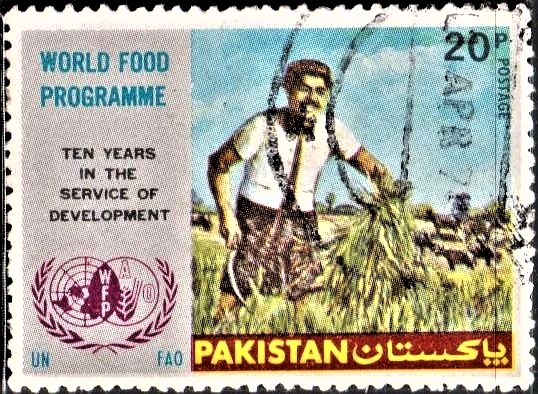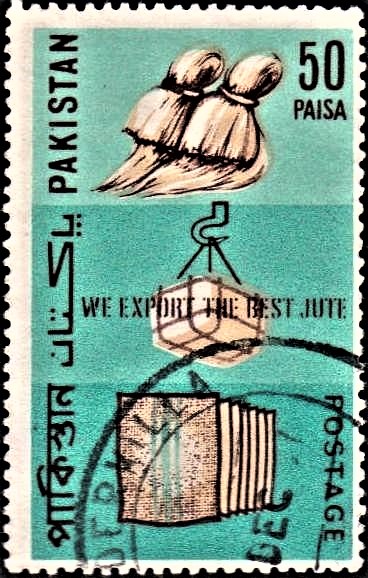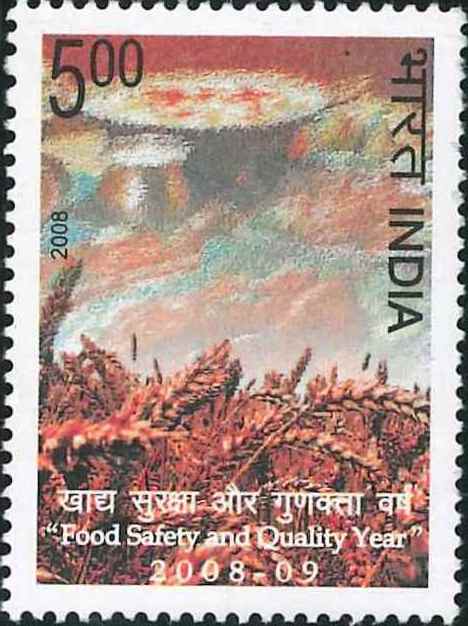
Pakistan on World Food Programme 1973
A commemorative postage stamp on the 10th Anniversary of World Food Programme (WFP), food-assistance branch of United Nations :
 Issued by Pakistan
Issued by Pakistan
Issued on Oct 15, 1973
Issued for : The series of the Commemorative Postage Stamps issued by the Pakistan Post Office mark the 10th Anniversary of the World Food Programme which started as an experiment in multi-lateral use of foods to promote economic and social development.
Design : Format of the stamp is vertical. In a square vignette at the right hand side, a typical Sindhi peasant is shown reaping a crop.
Type : Stamp, Postal Used
Denomination : 20 Paisa
Colour : Red / Blue / Yellow / Black
Size of Stamp : 44.50 x 32.50 m.m.
Size of Print : 41.50 x 29.50 m.m.
Perforation gauge : 13 x 13 (C)
Quantity printed : 5,00,000
Number of stamps in each sheet : 50
Process of printing : Litho Offset
Printers : The Pakistan Security Printing Corporation Ltd., Karachi
About :
- Set up by the United Nations and the Food and Agricultural Organization to use food as capital to bring practical and visible benefits directly to the people who most need them, the Programme has over the past ten years committed $ 1,200 million in food aid to nearly 550 projects of economic and social development in 88 developing countries. It has also provided $ 122 million in relief for the victims of natural and man-made disasters in 74 countries in 161 cases.
- The use of WFP food as development capital has helped to build roads, houses, schools, irrigation works and civic amenities, to resettle large communities, to increase meat and milk yields and to reclaim land. It has promoted diversification of corps and helped to provide green cover on eroded hills and plains, to feed nursing and expectant mothers and even to produce more coal and steel. It has also provided food and shelter to people fleeing from earthquake, flood and war and rehabilitated them.
- Since the inception of the Programme, WFP has committed to Pakistan more than $ 39.3 million, of which $ 1.2 million has been in emergency aid and the balance for projects. The most recent aid approved for Pakistan is to help mitigate the effects of the Indo-Pakistan war of December, 1971.
- $ 15.2 million were granted in a food-for-work project for the rehabilitation of 700000 war affected people in the districts of Sialkot and Lahore on their return to their homes. The returning farmers will receive rations over a period of eight and a half months while working to restore land, dwellings, roads and irrigation facilities to return to normal life. The ration consists of wheat, maize, pulses, sugar and vegetable oil. The maize is intended for feeding cattle which are essential for ploughing and draft work. The displaced families who lost their houses, cattle, food reserves, seeds and agricultural implements and other belongings during war need more help to restore peace-time conditions.
- In order to provide work for displaced persons in the areas of their temporary stay, the emergency grant of $ 1 million was followed by a grant of $ 2.7 million, on a quasi-emergency basis to three schemes, two of them for the construction of roads and the third for the improvement of canal banks. Construction of roads in Gujrat and Sialkot districts is estimated to employ 18,750 persons who will receive part payment in food. 5625 tons of wheat and 450 metric tons of vegetable oil are being distributed amongst them. The other road-building project is in the Tharparkar district of Sind Province. Nearly 20,000 workers are being employed to construct a total of 112 miles of roads. The WFP contribution to the project is 6,000 tons of wheat and 460 tons of vegetable oil.
- Canal banks in the Tharparkar district are to be improved and channels of the canals taking off the Indus river are to be cleared of silt. The WFP contribution to this project is 6,390 tons of wheat and 490 tons of vegetable oil. Part of it will be distributed to workers as part payment of wages and a part distributed free to some 37,500 people who are invalids, orphans or otherwise in need of help, if they have no breadwinner in the family.
- Pakistan first made use of the Programme in 1963 for emergency supplies to feed victims of the summer floods in East Pakistan. WFP responded with 750 tons of food, the cost of food and shipment was estimated at $ 415,000. This was followed by two more emergency operations in the same area – disastrous cyclones and floods in 1966 and 1968 – and one in West Pakistan, drought relief in 1966, on which a total of $ 3,425,000 in resources was expended.
- The first project of economic development assisted by WFP in Pakistan became operational in mid-1968, WFP supplying skimmed milk powder to the Karachi Milk Plant at a cost of $ 786,300. A similar project to increase milk supplies in Punjab is being assisted with $ 3.8 million. WFP is sending milk powder and butter oil to the Lahore Milk Plant. The total aid to increase milk supplies in Pakistan is estimated at $ 4.6 million.
- Livestock and poultry development is also being assisted by WFP at a cost of $ 6.3 million to the Programme. It supplied maize and sorghum for cattle feeding at Landhi, near Karachi. The same commodities are being supplied to raise more chickens in the country.
- The bulk of the resources of the WFP comes from the United States, but in all, nearly 100 countries provide food, cash and services in a world-wide partnership for development.
- Issued by The Director-General, Pakistan Post Office, Karachi.






